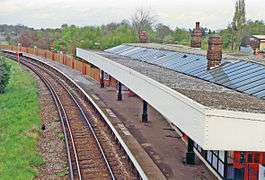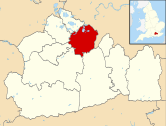Hinchley Wood railway station
| Hinchley Wood | |
|---|---|
 | |
| Location | |
| Place | Hinchley Wood |
| Local authority | Elmbridge |
| Coordinates | 51°22′34″N 0°20′31″W / 51.376°N 0.342°WCoordinates: 51°22′34″N 0°20′31″W / 51.376°N 0.342°W |
| Grid reference | TQ155652 |
| Operations | |
| Station code | HYW |
| Managed by | South West Trains |
| Number of platforms | 2 |
| DfT category | E |
|
Live arrivals/departures, station information and onward connections from National Rail Enquiries | |
| Annual rail passenger usage* | |
| 2004/05 | 0.261 million |
| 2005/06 |
|
| 2006/07 |
|
| 2007/08 |
|
| 2008/09 |
|
| 2009/10 |
|
| 2010/11 |
|
| 2011/12 |
|
| 2012/13 |
|
| 2013/14 |
|
| History | |
| Key dates | Opened 20 October 1930 |
| National Rail – UK railway stations | |
| * Annual estimated passenger usage based on sales of tickets in stated financial year(s) which end or originate at Hinchley Wood from Office of Rail and Road statistics. Methodology may vary year on year. | |
|
| |
| Hinchley Wood | ||||||||||||||||||||||||||||||||||||||||||||||
|---|---|---|---|---|---|---|---|---|---|---|---|---|---|---|---|---|---|---|---|---|---|---|---|---|---|---|---|---|---|---|---|---|---|---|---|---|---|---|---|---|---|---|---|---|---|---|
Legend
| ||||||||||||||||||||||||||||||||||||||||||||||
Hinchley Wood railway station is a railway station in the centre of the compact suburban village of Hinchley Wood in Surrey, England. The station is 14 mi 4 chains (22.6 km) from Waterloo and opened 45 years after the New Guildford Line through its site was built in 1930.
Design and amenities
The station is of an island construction with entrance footbridges from either side of the line. The building construction differs markedly from the older stations further down the line such as Claygate, the next station. The centre platform widens and tracks curve away to the north after the station due to the Flying junction west of Surbiton station.
There is a modern ticket machine and a waiting room (which is only open when the station is staffed). The station is staffed from Monday to Friday between 06:30 and 11:00 and covered by Closed Circuit Television (CCTV) at all times. There is a Help Point next to the Ticket Machine. Electronic boards advise customers of incoming trains in both directions. The station is not covered by the London Travel Card Zones, although the buses running on the north/south minor road east of the station are, principally the K3 service.
History
The station was opened on 20 October 1930 at the intersection of the Kingston Bypass, then the A3 London-Portsmouth Road and approximately half a mile south of Hampton Court Junction where the line joins the main London Waterloo line. The line itself was opened much earlier on 2 February 1885. Electrification as far as Claygate came in 1916, but the electric service was withdrawn during World War I, to be reinstituted along the full route from 12 July 1925 .
The operators of the line have been London and Southwestern Railway (LSWR), Southern Railway (SR), British Railways (BR) - latterly British Rail (Southern Region) and currently Network Rail with services franchised to South West Trains.
Services
South West Trains operate all the services on the New Guildford Line and all trains that stop at Hinchley Wood station. In the inbound direction, trains service the station every thirty minutes during both peak and off-peak hours. Local trains run at all times to London Waterloo, calling at Surbiton and running fast to Wimbledon, after that calling at all stations apart from Queenstown Road[1] fast trains supplement these services during peak hours, skipping stations between Surbiton and London Waterloo. Local trains take 33 minutes to reach London Waterloo.[1]
In the outbound direction, trains serve Hinchley Wood station every thirty minutes, calling at all stops on their way to Guildford.[1]
References
- 1 2 3 New Guildford Line timetable South West Trains Retrieved 2009-05-28
External links
| Wikimedia Commons has media related to Hinchley Wood railway station. |
- Train times and station information for Hinchley Wood railway station from National Rail
| Preceding station | |
Following station | ||
|---|---|---|---|---|
| Surbiton | South West Trains Waterloo-Guildford via Cobham |
Claygate | ||
